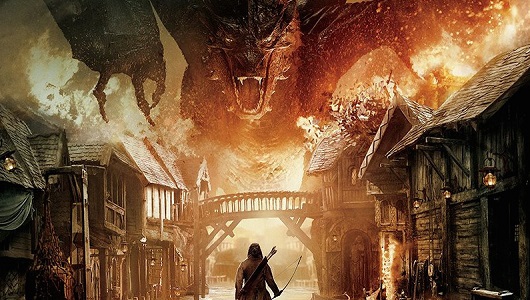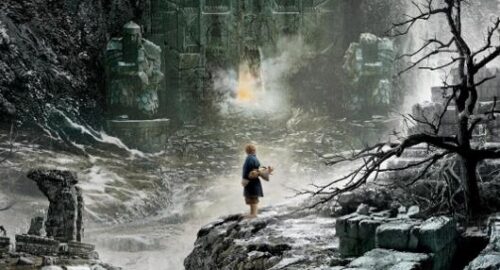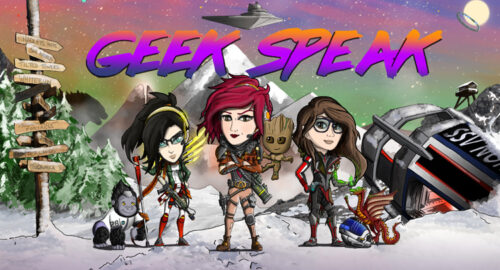Note: This review contains some spoilers for those who have not read the book.
If we are to believe what the marketing efforts are telling us, The Hobbit: The Battle of the Five Armies is ‘the defining chapter’ of Peter Jackson’s immense Middle Earth franchise. It’s the “#onelasttime” we’ll be able to delve into the sprawling world of orcs, hobbits and elves. It’s the final film that will provide a satisfying finish to what has proved to be a fairly disappointing extension of the original and beloved The Lord of the Rings trilogy. In other words it will provide enough of the heavy-weight fantasy favourite to sate even the most die-hard fans’ appetite – and in one sense, they were right.
• Director: Peter Jackson
• Exhibition: 2D/3D
• Rating: 12A
• Run Time: 144 mins
To be fair, Five Armies starts off at an exhilarating pace. We rejoin the story where part two rather abruptly left off, with Smaug the dragon (Cumberbatch) taking to the skies and unleashing his wrath on Laketown. It’s a spectacular showcasing of the capability of Jackson’s effects team and a visual treat to see an iconic villain brought to life in such dramatic fashion. While The Desolation of Smaug saw him do little more than smugly crawl around his mountain of gold, this allows for a second more striking introduction. However for all its splendour, Smaug’s dazzling reign of terror comes to an early finish. He is dispatched in the pre-title sequence, and it’s not a stretch to say it’s underwhelming considering we’ve spent about six hours dawdling towards this conflict. Non-book readers may find they have been promised dragon slaying, but have received an exploration of Middle Earth’s political climate following the dragon’s demise instead. While it is faithful to the source material, it feels like a rather unceremonious dumping off of the story’s emblematic antagonist. Coupled with what is barely more than a cameo from Sauron, whose arrival has been heavily hinted towards, it all feels a bit tight-fisted in terms of fan service.
With his vast horde of gold unguarded and his home (the mountain kingdom of Erebor) vacant, several vying parties move in to stake their claim, including our very own Thorin Oakenshield (Armitage). This shifts Armitage to centre stage and allows for a transition from stoic warrior archetype to the slightly more engaging king-gone-mad-with-power archetype. Thorin is almost Lear-esque as he slowly recoils physically and mentally into the vast walls and piles of riches left to him by his ancestors, much to the despair of his friends. At this point the consistent lecturing on the evils of gold and greed from a creative team that turned a 300 page children’s book into a trilogy of films may start to grate.
In this trade off for character development and screen time it is the supporting dwarves who get the poor deal. They are largely replaced by Luke Evans’ Bard and a handful of vacant elves, including original character Tauriel (Lily) and a notably gormless Legolas (Bloom). What’s most disappointing however, is Bilbo’s (Freeman) absence in the first two acts. Freeman’s confident portrayal has no doubt been a highlight of the trilogy, yet we seem to see more of “comedy” character Alfrid (Gage) whose tedious greedy-and-cowardly spiel is marched out at regular and increasingly irritating intervals.
As suggested by the subtitle, it is a battle that provides the backbone of the story. But this is not quite Helm’s Deep. With so many different factions, the majority of which (i.e. the ones that aren’t orcs) have some credibility to their claim, it’s uncertain who is deserving of our support. This ambiguity removes the desperation and urgency that made the clash at the centre of Two Towers so engaging, and results in a struggle to remain invested in the proceedings. In fact, as each army pitches up at the battlefield the tone becomes more farcical than fraught. But from the fluid elf army springing like waves over rows of grubby, grisly dwarves, to the trolls being used as all purpose demolition machines by their orc masters, there is certainly some fun and drama to be had in the ensuing madness. And as popular characters begin to drop like flies, a spark of significance is rekindled.
Inescapable comparisons to Two Towers only serve to remind viewers of the glaring issue that’s been nagging at The Hobbit since Gandalf first scraped his mark on Bilbo’s front door. Try as he might Jackson simply can’t deliver the same standard as that of his original trilogy.
It could very well be the definitive chapter, but it’s a Middle Earth movie to a fault, excessive and almost monotonously epic; it’s more of the same and then more again. More battles, more monsters, more sweeping panoramic shots and elaborate settings. But yet it lacks what made rings so special; the magic and suitable ambition of the source material, along with the simple novelty of it all. With such thematic and visual saturation, it leaves you wondering what fresh life the originally intended director Guillermo Del Toro, could have breathed into the franchise.
The Hobbit as a trilogy has unfortunately been unable to live up to its own monstrous hype. Each subsequent instalment has been in turn eagerly awaited and simply proven to be more of the same. We’ve spent nearly twenty hours in Middle Earth and the tried and tested formula is beginning look tired. There’s only so many times you can be awed by spectacular mountain scenery, or wowed by a shock resolution to an intense conflict. It’s an altogether agreeable and increasingly nostalgic visit to the fantasy land we are now so accustomed to, and has by no means left a permanent black mark on the reputation of Tolkien adaptations. But it is still stretched and overblown, and not what the original novel needed from an adaptation. Five Armies serves as concrete proof that we have had enough to last us a lifetime. With The Simarillion still ripe for a big screen portrayal, its probably best to hope the powers that be quit while still relatively ahead, no matter how tempting the piles of gold may be.
[youtube id=”ZSzeFFsKEt4″]








Eamonn
Jess, I could not agree more. You have given such an intelligent and concise voice to the emotions I felt when I left the cinema. We could almost be related! On my next trip I’ll be sure to read your excellent reviews berfore taking my seat.
Many thanks
Eamonn – your number 1 fan
marion
hi jess, i think you should b presenting Film Night 15 – very insightful, informative and top review!
marion Look forward to reading more of your film reviews,
marion
AndrevSlovik1982
I found myself, for the first time in these movies, sniggering at one or two scenes. And what the hell was that love story about. Like LOTR it didn’t need one. I will probably go back one more time to see it though.
The second half of the movie was one massive battle sequence. It was great to watch but at the end you wonder what was the movie trying to do. I think it was trying to, or at least should’ve been trying to set the scene for Lord of the Rings. To do this they needed to spend more time on the Sauron and the White Council. This would’ve revealed something new and provided intrigue for Tolkein fans. But then this might have lost the uninitiated.
Probably half the problem, as stated many times over, The Hobbit is a story in its own right and it is treated as a prequel to the LOTR; which it is to some extent but you’ve got to treat it as one or the other not both.
I think the Silmarillion provides more material for a proper prequel.